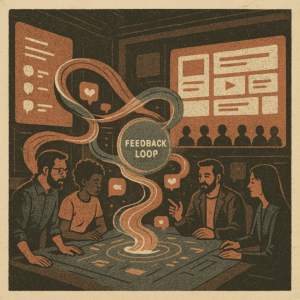There’s a moment that plays out in marketing teams everywhere.
You produce a solid blog post. It’s smart, well-structured, even gets a few internal thumbs up. Then… nothing. A couple of likes. A polite share from someone in leadership. One salesperson posts it—with no edit—and it sinks quietly into the noise.
Someone says, “Let’s just publish more.”
Wrong diagnosis. Wrong fix.
You don’t need more content.
You need that content to move further, faster, and in more voices.
Velocity beats volume—every time
Here’s how we think about velocity at Still Works:
Velocity is one strong idea travelling further—spoken in a thousand voices. Not a thousand pieces of content that are never spoken.
That means content shows up:
- In the brand voice (yes, publish the blog)
- In the voice of the leadership team (edited, reframed, relevant)
- In the voice of each salesperson (personalised, insight-driven, human)
This isn’t content marketing as a silo. This is content as fuel for the whole business.
From skyscraper content to internal compound interest
You’ve probably heard of the “skyscraper” method—find what competitors are doing, then make a piece that’s 20% better.
Useful. But we prefer a different approach.
Stand on the shoulders of your own team. Build on the thinking already inside your business.
Here’s what that looks like in practice:
- Three people—say, someone in sales, someone in product, someone in leadership—share sharp internal insights.
- Still Works identifies a theme and assembles a draft blog post. This becomes the first giant.
- Sales rep #1 gets a version to publish in their own voice, with a few of their own ideas added.
- It performs well—so we do the same with reps 2 through 5.
- Each version reveals something new. By the time we get to the sales director or the MD, we’ve iterated on that original idea 10–15 times.
That final piece doesn’t just “build on” the original blog. It’s sharper, more tested, more personal, and more impactful.
That’s content velocity.
Why this matters in the age of AI
It’s 2025. AI is everywhere.
By 2026, using it smartly won’t be optional.
And yet, most teams are about to drown in noise of their own making.
AI will tempt marketers to flood channels with average, unread content.
They’ll chase “scale” by publishing more… of less.
But the winning teams will use AI to scale insight—not just output.
They’ll take a few truly valuable pieces and repurpose them with care:
- In different voices
- For different formats
- In ways that actually get seen and shared
That’s how you rise above the noise. That’s how content drives deals.
The real role of AI in content ops
Let’s be clear: AI is not here to replace your marketers.
But if your marketing team is supposed to:
- Interview sales
- Curate insight
- Write a blog
- Create 6 LinkedIn posts
- Personalise them for 12 sales reps
- And repurpose that into outreach…
…they will burn out. Or give up. Or do none of it well.
Still Works changes that.
We do the drafting. We help curate the insight.
You keep the voice. The nuance. The final say.
We don’t replace humans. We give them leverage.
That’s the point.
The single principle we teach every marketing team:
“Scale content by personalising it—not by producing more of it.”
The cost of low velocity
If you’re sitting on great ideas but publishing generic content, here’s what happens:
- Sales loses faith in marketing.
- Marketing loses time chasing quantity.
- And customers never hear the stuff that actually makes your company great.
You’ll still grow—but slower. Harder. With more manual effort from sales.
Now flip it:
- You create one brilliant piece.
- It’s repurposed across 10 voices.
- Sales uses it. Leadership shares it. It opens conversations.
- Marketing becomes the most respected function in the company.
That’s what content velocity looks like.
That’s what we’re here to build.
Final thought:
You don’t need more content. You need the right ideas, moving faster, through more voices, with less friction.
Let’s go make it happen.


